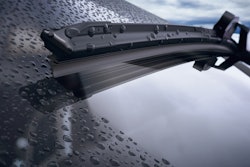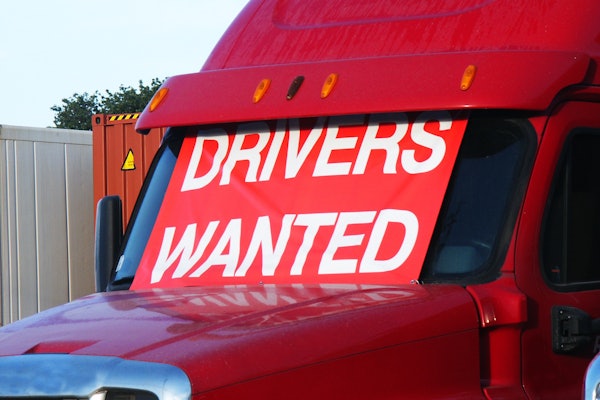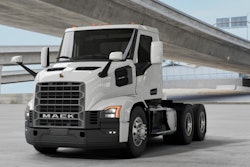There's no more satisfying feeling for a truck driver than the airbrake knob smacking the palm of your hand at the end of a grueling haul, hearing that "pshhh" of the air system and knowing that you're home.
Many new heavy tractors this year won't include that sensory satisfaction as the push/pull knobs are largely being replaced with paddle-style switches that electronically activate the pneumatic parking brake for a smack-free experience.
"It's similar to an electric-over-air system," said Volvo Trucks Product Marketing Manager Bobby Compton, adding the electronic control system enables a smarter braking system, which translates to improved safety. "When it's a pneumatic button, you can't have things auto activate. When it's an electronic button, you can send electronic signals"
The air system still lies underneath, noted Dan Zula, Bendix product group director, brake control.
"It's just the convention of how they're activated by the human," he said. "I think the paradigm shift is it's no longer a direct control of the spring brake system. It's a request. You push that paddle, you pull that paddle, and you are asking the computer to do it fully. So now there's software involved."
The software, Zula said, plays a critical role in driver support by monitoring "whether or not the human has forgotten to do something."
"Where we had safety-critical risks before – maybe the driver forgetting to release the spring brakes before pulling away, and they could have an incident where the wheels got packed because they drove through it, or they forgot to apply the park brake when exiting the vehicle – we now have software involved monitoring a bunch of inputs, a bunch of conditions on the vehicle, and setting the park brake or releasing the park brake on behalf of the driver as a safety mechanism for a higher level of safety," he added.
Taking the air lines out of the dash not only makes the cab quieter, but an electronic parking brake control also allows fleets to tailor safety features that could prevent roll-away accidents, for example, by automatically engaging the parking brakes if the driver forgets. The electric parking brake systems use interlocks and can be configured to automatically engage the brakes based on various factors, such as the driver exiting the cab, unbuckling their seatbelt, or truck speed.
"Say the driver gets distracted for a second, gets out of the cab and forgets to park the vehicle, and it rolls down a little grade and into the highway," said TJ Thomas, Bendix director of customer solutions and marketing. "The system then can detect, 'Hey, I don't see a driver (no weight in the seat). Nobody parked the vehicle, but I'm starting to see wheel speed pick up a little bit. I'll park it for him,' so to speak. It's not replacement for the driver parking. It's a partial safeguard for in case that situation happens."
"Because you're able to add the code. If you're an Excel guy, you know the if/then statements," Compton added. "If the driver opens the door and the truck is in gear, then set the brakes."
Electrification on the rise
Electronics are increasingly becoming a larger part of the air brake system as a whole. For example, the Fifth Generation Freightliner Cascadia introduced the Intelligent Braking Control System (IBCS), a closed loop Electronic Braking System featuring drive-by-wire technology with full pneumatic backup.
On its all-new Pioneer model, Mack introduced its Electropneumatic Braking System (EBS).
"This is a completely new pneumatic architecture that reduces parts complexity while increasing performance and safety for the driver," said Blake Routh, Mack senior highway product manager. "The EBS system enables precision control of the air pressure at wheel ends, while also adjusting to meet the air pressure needed in different driving situations."
Freightliner's new Endurance Braking blends the engine retarder and service brakes together by applying the foot pedal – a feature that reduces brake pad wear, extending the life of the brakes. Electronic brakes also enable Comfort Braking to provide a driver a smoother braking experience by evenly applying brake pressure distribution, decreasing lining wear and improving driver comfort on the road, Freightliner said.
Additionally, the electrically controlled system allows for fewer components for a simplified installation.
"For the driver, this means smoother, more consistent braking, especially at low speeds, and allows the driver to avoid changing brake pedal pressure under different load conditions," Routh added. "In regards to driver safety, there are built-in features like automatic parking brake engagement, which will engage the parking brake if the driver opens the door while in gear. Truck rollaway can be a major issue in our field, so a feature like this can help prevent catastrophe. Overall EBS is a better performing system that reduces components, while delivering a better performing, safer system for the driver."
Bernie LaBastide Jr., International Motors chief technical engineer, said customers are choosing the electronic switch for its enhanced safety and driver satisfaction, as the new system "replaces the traditional air valve controls on the dash with a more user-friendly electronic switch, while maintaining the rest of the traditional and reliable air brake system."
It's user-friendly, Compton said, but also maintenance-friendly in this case. Replacing the pneumatic buttons with electric switches simplifies troubleshooting in the event of an air leak.
"The big tractor protection valve that was on the left-hand side of every truck that had what felt like hundreds of airlines running through it, that's all gone," he said. "There's still a tractor protection valve. There has to be. It's a safety requirement. But that valve is located in a different place, and you don't have to have all of those same connections anymore. You really minimize the amount of pneumatic connections, so you minimize the amount of air leaks."
Electronically controlled brakes, available on Volvo's new VNL and VNR models, are also safer in worst-case scenarios, Compton added.
"If you were driving down the road and lost your service brakes, with the old systems you couldn't just pull the emergency brake because what would happen? It would lock up. Everything would lock," he said. "In this new system, if you are in the situation of losing your service brakes and you deploy (the brakes), it recognizes that you're doing 50 miles an hour, for example, and it'll slowly set them at that point."
Another consideration is driverless trucking, Zula noted. As autonomous platforms get more sophisticated, many of these manual and tactile processes (like pushing and pulling an air brake knob) will have to be automated.
"You can't autonomously drive if you can't autonomously release park brake," he said. "Electrification in the park brake space is also important for robo trucks."













